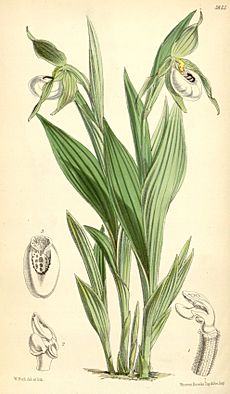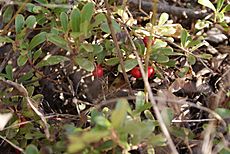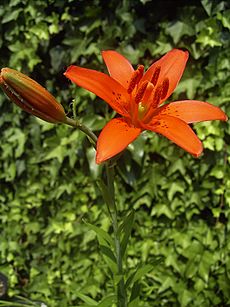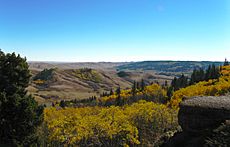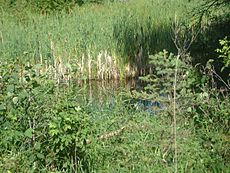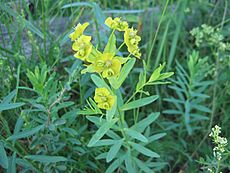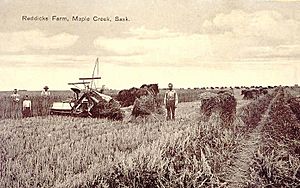Flora of Saskatchewan facts for kids
The native flora of Saskatchewan includes many kinds of vascular plants, plus other plant-like organisms such as algae, lichens, fungi, and mosses. Some plants that are not native to Saskatchewan have been brought in. While some of these non-native species are good for gardening and farming, others have become invasive and harmful weeds. Saskatchewan works hard to protect its species at risk in Canada.
Scientists have studied the growing season in Saskatchewan. They have divided the province into plant hardiness zones. These zones help us understand which plants can grow best in different areas based on the length of the growing season and the weather. The types of plants you see also change depending on how high the land is, how much moisture there is, the soil type, and the weather. The study of ethnobotany teaches us how people and plants have always been connected. It shows how people have used plants for food, medicine, and even to create new technologies. The Government of Saskatchewan has chosen three native plants as its official provincial symbols.
Contents
Plants of Saskatchewan
Growing Season and Climate
Saskatchewan has a continental climate, which means it has big changes in temperature between seasons. This leads to a short growing season. On average, the province has about 159 to 160 days without frost. In the far north, this drops to only 85 to 95 frost-free days.
In 1967, Canadian scientists created a map of Plant Hardiness Zones. These zones look at things like how long the frost-free period is, how much rain falls in summer, the highest summer temperatures, the lowest winter temperatures, and wind speed. Zone 0 is the harshest for plants, and Zone 8 is the mildest. This information helps people know which plants will survive in different parts of Saskatchewan.
An important development in the late 1800s helped farmers. A type of wheat called Red Fife matured 20 days faster than other wheats. This meant farmers could harvest their crops before the autumn frost arrived.
Protecting Plants: Rare and Invasive Species
Saskatchewan is home to 367 rare species of vascular plants. Out of these, 135 are considered endangered.
The Small White Lady's Slipper is the only plant that has disappeared completely from Saskatchewan, meaning it is extirpated from the province. Endangered plants include the Sand Verbena, Western Spiderwort, Tiny Cryptantha, and Hairy Prairie-Clover. Threatened plants include the Slender Mouse-Ear Cress. To help protect these plants, there are reports like "Species at Risk In SK" and "Rare Plant Survey Guidelines."
Saskatchewan also has a law called The Weed Control Act. This law helps manage plants that were brought to Saskatchewan and have become a problem for the natural environment. An example of such a plant is leafy spurge. There are also reports like "Invasive Species and Noxious Weeds of Saskatchewan" to guide these efforts.
Saskatchewan's Plant Symbols
Saskatchewan has chosen special plants to represent the province.
- The provincial tree, chosen in 1988, is the paper birch (Betula papyrifera).
- The provincial flower, chosen in 1941, is the Western red lily (Lilium philadelphicum var. andinum). This is a protected species.
- The provincial grass, declared in 2001, is Needle-and-thread grass (Hesperostipa comata).
Plant Zones Across Saskatchewan
Saskatchewan is part of the Holarctic Kingdom, which is a large area where similar plants grow. Within this kingdom, Saskatchewan has two main plant regions. The Circumboreal floristic region covers the cool northern parts. The North American Atlantic Region covers southern Saskatchewan, which is a warmer Midwestern Plains zone. These zones have some unique plants that grow only there.
Different geographic factors create a rich variety of plants in Saskatchewan. From north to south, you can find many different plant zones. These zones are also called ecoregions, which means they have similar soil types and landforms.
Cold Northern Woodlands
In the far north, on the Canadian Shield where the weather is coldest, you find subarctic lichen woodlands. Common trees here include black spruce, jack pine, and white spruce. This area also has peatlands, bogs, fens, and areas of permafrost. Yellow and Grey Reindeer moss often covers the ground. This cold area is like Canada's hardiness zone 0a.
The circumpolar boreal forest, also known as the taiga, is found further south in the north. It is mostly made up of conifer trees or stands of aspen and poplar. This area is full of lakes, bogs, forests, and rocky areas. Black spruce and jack pine are still the main trees. Forest fires are common here, and Fireweed often grows in areas that have burned. Lichens like Cladonia cetraria and C. tereocaulon cover the ground. Feather mosses, such as Stair-Step Moss, grow underneath. This area is in plant hardiness zone 0b.
A special place in the north is the Athabasca Basin. The Athabasca Sand Dunes are a unique part of the Canadian Shield. These large sand hills are in northern Saskatchewan, next to Lake Athabasca. Not many plants grow directly on the sand hills. However, you can find Blueberry, Bearberry, Sand Heather, Crowberry, and various grasses. This area is home to 10 plant species that are found nowhere else, including four unique types of Willow.
Southern Boreal Forests and Wetlands
The Southern Boreal Forest has a mix of trees like jack pine, trembling aspen, white spruce, and tamarack. This is where much of Saskatchewan's forestry industry operates. Lichen and stairstep moss cover the ground. Shrubs like Bearberry, low-bush cranberry, and Red Osier Dogwood are common.
This region also has many wetlands like peatlands, fens, and marshes, especially in areas with wetter soils. About 16% of the boreal forest is wetlands, where the water table is at or above ground level. Saskatchewan is the world's largest producer of wild rice, which grows in these wet areas.
In peatlands, you can find Bog Labrador Tea, Sphagnum mosses, and cloudberry. Bogs are very acidic, have high water levels, and low nutrients. Fens support brown mosses and plants like Reed Grass, Willows, marsh cinquefoil, and False Solomon's Seal. Fens have slow-moving, nutrient-rich water. Marshes are surrounded by willows and grow plants like Marsh reed grass, Kentucky blue grass, Fowl blue grass, beaked sedge, and bulrush. Marshes have slow, slightly alkaline water, rich in nutrients and minerals. Bogs, fens, and marshes together form what is called muskeg. The Southern Boreal Forest is in hardiness zone 1a.
Aspen Parkland: Where Forest Meets Prairie
The Aspen parkland is a transition area between the mixed forests and the open prairie grasslands. It has less rain and a slightly warmer average temperature of about 1.3 °C (34.3 °F). Trembling aspen trees form small groups called "bluffs" or "shelter belts," which are typical here.
The eastern part of the Aspen Parkland has tall grass prairie with plants like Big Bluestem and Porcupine grass. Other trees include Bur Oak, Green ash, Manitoba maple, and balsam poplar. In central Saskatchewan, you find native Fescue grasslands with fescue grasses and western porcupine grass. Aspen trees are still common, with willows in wetter spots. The western parkland has Needle and thread grass covering the ground. Tree groves here include aspen, willows, and balsam poplar.
Throughout the Aspen Parkland, in low-lying, moist areas, you'll find dense groups of shrubs. Some of these include Saskatoon berries, pin cherry, choke cherry, hawthorn, western snow berry, woods rose, Wolf willow, and Canada buffaloberry. The marshes and small ponds (sloughs) in the Aspen Parkland have plants similar to those in the Southern Boreal Forest marshes. This area falls into plant hardiness zones 1b, 2a, and 2b.
Prairie Grasslands: Dry and Mixed Areas
The Mixed Grass Prairie is a drier grassland area, found in hardiness zones 2a and 3a. In higher, dry spots, you'll see big sandgrass and blue grama grass. In lower, salty areas, plants like alkali grass, salt grass, foxtail or wild barley, and arrowgrass grow.
In areas with moderate moisture, needle and thread grass, northern wheat grass, hair sedge, and bottle sedge are common. Cottonwood trees and willows grow along riverbanks.
Southwest Saskatchewan has very dry weather and a semi-arid climate. Dry mixed prairie is found south of Cypress Hills and in the Great Sand Hills area near Leader. Here, you can find Prickly pear cactus, blue grama grass, needle and thread grass, silver sagebrush, and June grass.
The Cypress Hills have a higher elevation, over 1,200 meters (3,900 ft). This means they have cooler temperatures and more rain, making them more like a boreal forest than the surrounding prairie. Lodgepole Pine trees grow only in the Cypress Hills area of Saskatchewan and in the Rocky Mountain forests. Aspen and white spruce are other trees found in the Cypress Hills. Shining leaved meadowsweet, low larkspur, and pinegrass cover the ground.
Plants and People: Ethnobotany
Many native plants in Saskatchewan can be used as vegetables, teas, wine, jams, syrups, and flour. Other plants have qualities that can be used as medicine. The way different plants are harvested varies. Shoots and leaves of some plants are picked, while roots and tubers of others are gathered like potatoes. When looking for native plants, it's important to know the right season to harvest them and where to search.
Marshy pond edges might reveal broad leaf cattail or yellow pond lily. Disturbed areas often have chickweed and plantain. Asparagus shoots grow near roadsides. It is very important to know that some plants are poisonous, and some edible plants have poisonous look-alikes. Always be sure what a plant is before touching or eating it!
Strawberry, wild mint, and Labrador tea leaves can be steeped in hot water to make tea. Saskatoons, blueberries, and other berries can be picked by hand to make jam, jelly, syrup, and juice. Blackberry, dewberry, blueberry, buffaloberry, currant, huckleberry, prickly pear, raspberry, and rose hips all make delicious jams or jellies. Pies can be made from currants, blackberries, mountain ash, or strawberries. You can also hull grass seeds and grind them into flour.
Herbal solutions used as remedies for sickness could be drunk as tea, used as ointments, or poultices (a soft, moist mass applied to the body), or inhaled as smoke or steam. Cow Parsnip and broad-leaved water plantain are two herbal remedies that were used by the Cree people. However, cow parsnip has a poisonous look-alike species, the western water hemlock.
Plants in Saskatchewan have also helped people in other ways. Trees provide wood, like birch bark for canoes. Reeds could be shaped into whistles and baskets. Sphagnum mosses were used for their insulating qualities, and they were also absorbent for diapers and had properties that helped prevent bacteria.
Plant Experts: Botanists
Eugène Bourgeau (1813-1877) was a botanist who traveled with Captain John Palliser (1817–1887) and Henry Youle Hind (1823-1908) during the British North American Exploring Expedition between 1857 and 1861. Their early investigations suggested some areas were not good for farming. One particularly dry area was named the Palliser's Triangle.
John Macoun (1831-1920) was a naturalist who went to the prairies in 1872 with Sir Sandford Fleming. He believed the region had good potential for agriculture. Isabel M. Priestly (1893-1946) was a botanist who collected plants and helped start the Yorkton Natural History Society. Dr. William P. Fraser, a professor at the University of Saskatchewan, has an herbarium (a collection of dried plants) named after him. His plant collection was later moved to the Department of Plant Ecology. Dr. John K. Jeglum, a research botanist, also studied plants in Saskatchewan for his doctorate at the University of Saskatchewan.
Farming and Forests
Farming in Saskatchewan is about growing different foods, animal feed, or fibers for people and animals. A newer part of the farming economy is making biofuel from plants, like ethanol or biodiesel. Modern farming uses a lot of technology to grow cash crops that are sold to help the economy of Saskatchewan. The types of crops grown depend on the specific ecozone and geography of the area.
Farming methods have changed a lot over the years. The nomadic hunter-gatherer lifestyle of the First Nations people and the early immigrant farmers with their oxen and plows are very different from today's farmers. Modern farmers use large machines to work huge amounts of land or care for many animals.
Challenges for Saskatchewan farming include finding ways to manage water in dry areas, improving dryland farming techniques, and deciding whether to grow genetically modified foods. Some crops have also faced problems with diseases, which can affect how they are sold.
Canada's production of wheat, oats, flaxseed, and barley mainly comes from Saskatchewan and the other prairie provinces. Saskatchewan still has cattle ranching in the southwest. However, grain farming and growing crops like wheat, oats, flax, alfalfa, and rapeseed (especially canola) are most common in the parkland area. Mixed grain farming, dairy farms, and mixed livestock grazing lands are found in the central lowlands. Since 1996, March 24 to 30 has been celebrated as Agriculture Week in Saskatchewan.
In the northern part of the province, forestry is very important. North of the treeline, Saskatchewan has 350,000 square kilometers (140,000 sq mi) of forests. These forests provide resources for the Saskatchewan forestry industry, including lumber and materials for pulp and paper.
See also
- Canadian Prairies
- Canada's landforms
- Canadian Shield
- Forestry Farm Park and Zoo
- List of ecoregions in Canada
- List of terrestrial ecoregions (WWF)
- List of ecoregions in North America (CEC)
- List of Wildlife Species at Risk
- Prairie


